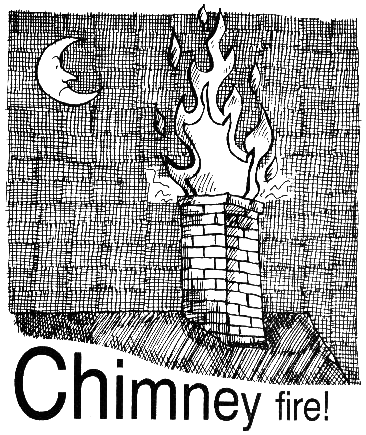Chimney Fire
Chimeny Fires Do Happen!
Few flues are stout enough to come through a severe chimney fire unscathed. There is no such thing as a "friendly" chimney fire that will safely clean out your flue. With a roar like a freight train, it can crack open the flueliner and chimney and spread to the structure of the house.
"Flue fires are perennial". They happen every winter when creosote deposits on the smoke chamber and flue walls are set ablaze by high heat or by flames licking up the chimney.
A chimney fire can be exciting and light up the night, but it is NEVER a laughing matter. Here's how it happens and why it can threaten your life and your property.

Anatomy of a Flue Fire
Heated wood releases hydrocarbon gases. When these get hot enough (about 1100 degrees F) they mix with air and catch fire. When hearth or woodstove fires smolder, unburned gases condense and deposit on the stovepipes and the flue as runny acids and liquid tars that harden into creosote. Both a cool flue and steam from green or wet wood encourage this condensation.
Creosote can appear as any of the following:
- a sooty powder
- a gummy mess
- a hard glaze
- or a deposit that looks like burnt marshmallows.
Tar-glazed Creosote
This type of creosote makes for the hottest burning fuel for a flue fire. The thicker the layer of creosote, the hotter the fire. The heat generated by this infernal can raise to ignition point, the temperature of wood structures on the other side of a chimney, so that it also starts to burn threatening the entire house. Wood doesn't necessarily need contact with fire in order to ignite. It just needs"air, oxygen and enough heat."
A house may survive the first chimney fire, but the intense heat has started pyrolyzing* nearby combustibles, thus lowering their ignition temperature. This makes the structure very vulnerable to a subsequent chimney fire. A damaged flue-liner can no longer protect either the chimney or the house. And instead of being all burned out, creosote may instead be all puffed up to the point of partially or completely blocking the flue.
What is Pyrolysis?
Pyrolysis is chemical decomposition caused by heat. Severely pyrolyzed wood can ignite at only 2l2 degrees F, while it would normally have a catch-fire temperature of about 500 degrees F, before it had any exposure to intense heat.
Fire in Your Chimney!
If it happens to your chimney get everyone out of the house, because fire can flash right through the house with incredible speed. Then call the fire department from a safe distance such as a neighbors house or from your car. Do not try to put out the fire and do not hesitate leave immediately. Afterwards, if your house is still standing, call a chimney service professional to clean and inspect the chimney as well as assess the damage. Your chimney will need to be repaired and probably relined to make it safe for further use.
Note: DO NOT LIGHT ANOTHER FIRE in the stove or fireplace until you've had the chimney professionally inspected and repaired!
Chimney renovation can be expensive. If you have documentation of a flue fire through the fire departments records if they where called or an examination and inspection report and estimate by a professional chimney sweep, your homeowner's insurance may cover the cost. Your insurer would rather underwrite a repair or reline your damaged chimney rather than risk the possibility of having to processing a claim for your house and its contents destroyed by a fire from and unsafe chimney.
Also make sure you have the reference in your policy that covers a wood burning appliance as insurance companies require notice and charge an additional premium to cover this eventuality. If your insurance agent says a chimney fire is a "friendly fire," dispute that notion. A flue fire is most "unfriendly," have your professional chimney sweep explain this to them.
Excessive creosote build-up is caused by one or more of the following:
A flue too big for the appliance it serves. Most open fireplace flues are too big to be used to vent a woodburning stove or a fireplace insert with out a liner. This causes a sluggish fluedraft effect and gases expand to fill the space then quickly cool down, allowing creosote to deposit on the chimney walls, where it sticks like glue.
Solution: Install a stainless steel liner that is properly sized for the stove or fireplace insert. A liner is required by the building code in Ontario when installing a fireplace insert in an open fireplace
Poor woodburning habits, such as severely limiting the air supply in a stove to achieve an all-night burn can cause a sluggish draft and a smoldering fire that doesn't get hot enough to burn the volatile gases released by the wood and creosote will form quickly.
Solution: Burn smaller, hotter fires using seasoned firewood with a good draft never air-starve the fire. This way, the heat will quickly warm up the flue and increase the draft, while volatile gases burn up in the stove the way they should and your chimney will have much less build up.
An oversize or outdated stove; When a stove is too big for the space it heats, it's likely to be burned in the closeddown, creosote-producing mode. Also, many stoves sold in the 70's and early 80's are now obsolete. They're not as cleanburning as the newer certified models designed to meet new emissions standards.
Solution: Replace your old stove with a new high-tech unit correctly sized for the space you want to heat and matched with the proper venting system.
A neglected chimney flue. Many of us don't give our chimneys a second thought until something goes wrong.
Solution: Find an experienced, certified professional chimney sweep right away. Put your solid fuel burning system on a regular inspection and maintenance schedule.
Do-lt-yourselfers. Stove installation and chimney service work are "NOT" home handyman chores. They call for professional know-how, special training, technical expertise and familiarity with the local building codes.
Solution: Always intrust installation and maintenance to a professional
A woodburning appliance with improper venting and an unlined chimney cannot give the house proper protection or provide you with efficient heat.
What can you do?
Ask a professional about good fluliners; usually stainless steel. They are designed both for unlined chimneys and as replacement for damaged clay tile liners.
If your house and chimney were lucky enough to survive that first flue fire, don't wait for a second or third event to do them in. Now that you've learned how a chimney fire can take the whole house down, do use caution and take preventive action.
In keeping with tradition here we are three generations of Chimney Sweeps serving Dufferin County, Caledon, Erin and Palgrave areas.
For decades people have had a love affair with wood fires, a cosy fire on a cold blustery night curled up with a good book and a warm drink is the ultimate in comfort on a winter evening. "The perfect fire" is "all woodheat can be.

Give Us a Call
Phone: 519-941-5213

Send Us an Email
thechimneysweep@sympatico.ca
Home | About Us | Services | FAQ’s | Knowledge Base | Resources | Contact Us
Website Design by Rood's Media




